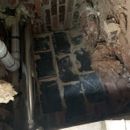Sealing Crawlspace Beneath Unconditioned Bathroom
Hi all,
I’m Gennaro, in Washington, DC (zone 4a). Thought I’d separate this question out since it’s pretty different from the other I asked.
I’m trying to address a tiny crawl space – less than 30 square feet – under my first floor half bathroom. It was left poorly insulated with fiberglass by the people who flipped this house. Cold floors above, worries about pipes freezing, all that. Our home energy audit recommended encapsulation, but our hvac ductwork doesn’t go anywhere near that bathroom or the crawl below, so no option for conditioned air. All that runs through there are waste pipes from the bathroom and exhaust from the basement dryer.
We’re getting closed cell foam for our attic, and it’s relatively cheap to add on this job. But what’s the best way to insulate?
1. Vapor barrier on the floor, foam the exterior walls, find the tiniest exhaust fan ever.
2. Vapor barrier on the floor, air seal and insulate the ceiling with foam, open a vent to the outside (currently none, just a leaky hatch)
3. Something else?
Martin’s article got me thinking about the exhaust/conditioned air question, but none of the contractors I’ve spoken to have even mentioned it. Is this space tiny enough that we can rely on air leakage to condition the space? There is certainly a lot of that going on currently.
Thanks for the help…included some pictures (that have flipped themselves) for reference
GBA Detail Library
A collection of one thousand construction details organized by climate and house part











Replies
If you have the foam contractor onsite, I would go ahead and do the crawlspace foundation walls (after putting down a heavy-duty liner). You may or may not need to ventilate the space. If the house is older, there may be enough leakiness to keep some air exchange going.
I feel this is the definitive article on the subject: https://www.buildingscience.com/documents/insights/bsi-009-new-light-in-crawlspaces
You can go either way. Note that in our climate (I'm in DC too) the major source of dampness in crawl spaces is summer humidity. If you're going to be bringing in outside air you need to either have it wide open -- less than 50% coverage of the walls -- or all of the wood has to be covered with something that protects it from moisture and vapor. Unless the space is quite open in the summer it is going to stay cool, and when summer air gets in there it will condense. You only need a tiny amount of air infiltration for humidity to go to 100% and then bad things will happen.
So this may sound like a vote for encapsulating the walls, but either way can work. Presumably there is a basement adjacent to this crawl space, and a factor as well is how you're going to transition between the two spaces.
If you encapsulate the crawl space, it will be part of the conditioned space of the house, but it doesn't need air flow. There are lots of "dead" spaces in a typical house -- spaces that are inside the building envelope but sealed off -- like soffits and chases. A properly encapsulated crawl space can be dead space.
Thanks Steve and DCContrarian, especially for that article that I hadn't run across yet.
There is a basement - that's where the dryer exhaust pipe is entering from, and the waste pipe coming from the first floor bathroom passes through the crawl space and into the basement to join a stack there. What do you mean exactly by transition between them? Currently it's a noticeably leaky connection that I previously tried to tighten up with canned spray foam along the edge of the basement ceiling.
I was firmly on team encapsulation until I read all the articles demanding an hvac register in the crawl space. Sealing off the joists with closed cell foam seems fine, but then all of the bathroom pipes are buried in foam should they need to be serviced.
"What do you mean exactly by transition between them?"
Presumably the basement is treated as interior space? At some point there is a boundary between interior and exterior. Depending on how you do the crawl space it's either the boundary between the crawl and the basement, or between the crawl and the outside. If the boundary between the basement and the crawl space is difficult to insulate that's another argument for making the crawl part of the interior.
BTW, the subject line editor did no one any favors here. Original title was "Tiny crawl space." Revised title is "Sealing Crawlspace Beneath Unconditioned Bathroom." The bathroom isn't unconditioned. The question is really, does an encapsulated crawlspace need to be conditioned.